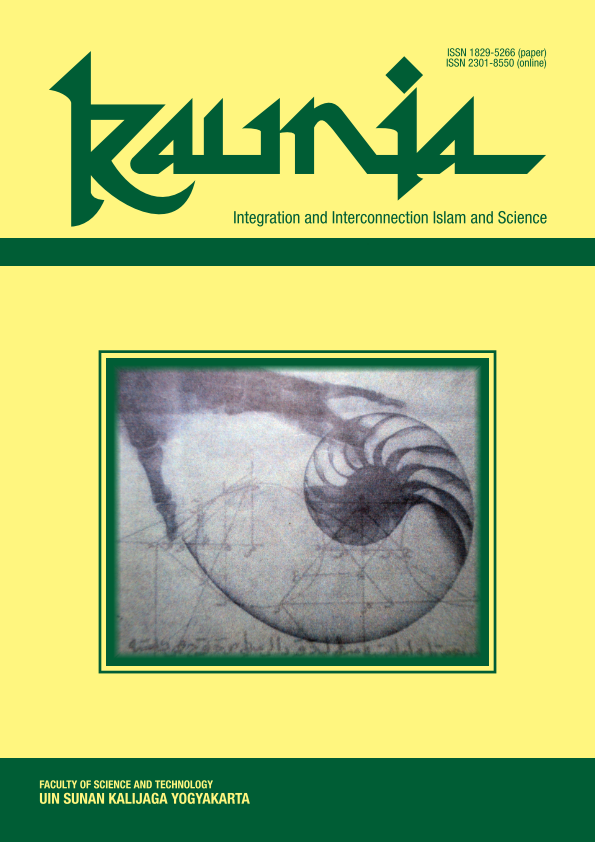Climate Change Impacts on Indonesian National Parks
DOI:
https://doi.org/10.14421/kaunia.1413Keywords:
climate change, Indonesia, national park, tourism, adaptation, mitigationAbstract
Indonesia is the third largest tropical forest country. There are about 125 million Ha of total Indonesian forests, in which 27 million Ha are conservation areas. Besides conserving species and ecosystem, national parks are also natural solutions for climate change problem. Despite its vital roles in mitigating climate change, national parks are affected by climate change. Changing in climate alters forest composition and structure, scenic beauty, cultural heritage, biodiversity, and ecosystem services. These impacts eventually could harm tourism, and national park development. National park is an interesting landscape to study climate change. It is a nature conservation area, has native ecosystem, managed using zoning system and mainly used for research, education, and nature tourism. Many of the national parks are protected from urbanization, timber harvesting, grazing, and other non-climate factors. Therefore, it can be said that human is one of the main causes of climate change. Taking into account the nature of national parks and inevitable impact of climate change, research needs to be done to assess how climate change affects national parks. Using literature review, this paper will explore to what extent the research on impacts of climate change in Indonesia national parks has been done and provide information regarding existing mitigation and adaptation actions.References
Australia Indonesia Partnership, 2009. Kalimantan Forests and Climate Partnership (KFCP). http://formin.finland.fi/public/download.aspx?ID=48885&GUID=%7B9B0BA3BA-25BF-4FEA-985B-B6DADCA60EAC%7D
BFN.2011. Project Profile: Bukit Tigapuluh. Environmental education for Bukit Tigapuluh https://www.bfn.de/en/activities/international-nature-conservation/projects/indonesia.html
Case, M., Ardiansyah, F., Spector,E. 2007. Climate Change in Indonesia Implications for Human and Nature. http://wwf.panda.org/?118240/
Directorate General of Ecosystem and Natural Resources Conservation. Statistic 2016. http://ksdae.menlhk.go.id/assets/publikasi/Draft_final_Statistik_Ditjen_KSDAE_2016_CETAK_FIX.compressed_.pdf
EPA, 2017. International Climate Impact. https://19january2017snapshot.epa.gov/climate-impacts/international-climate-impacts_.html
GFDRR. 2011. Climate Risk and Adaptation Country Profile.
https://www.gfdrr.org/en/publication/climate-risk-and-adaptation-country-profile-indonesia
Gonzalez, P. 2016.Melting Glaciers, Shifting Biomes and Dying Trees in Our National Parks-Yet We Can Tale Action on Climate Change. Available online: http://theconversation.com/melting-glaciers-shifting-biomes-and-dying-trees-in-our-national-parks-yet-we-can-take-action-on-climate-change-61883
Harjadi,B. 2016. Climate Change Vulnerability Analysis of Baluran National Park. Forum Geografi,Vol 30 (2) December 2016: 140-149. ISSN: 0852-0682, EISSN: 2460-3940
House of Representatives of the Republic of Indonesia. 2011. Indonesia Country Report on Climate Change and Tourism.
IPCC, 2007: Summary for Policymakers. In: Climate Change 2007: The Physical Science Basis. Contribution of Working Group I to the Fourth Assessment Report of the Intergovernmental Panel on Climate Change [Solomon, S., D. Qin, M. Manning, Z. Chen, M. Marquis, K.B. Averyt, M.Tignor and H.L. Miller (eds.)]. Cambridge University Press, Cambridge, United Kingdom and New York, NY, USA.
IUCN and WCPA. 2016. Protected Areas Climate Change Specialist Group. Strategic Framework 2016-2020. https://www.iucn.org/sites/dev/files/content/documents/paccsg_framework_aug2016_high_res.pdf
Jantarasami, L. C., J. J. Lawler, and C. W. Thomas. 2010. Institutional barriers to climate change adaptation in U.S. national parks and forests . Ecology and Society 15(4): 33. [online] URL: http://www. ecologyandsociety.org/vol15/iss4/art33/
Josef Leitmann et al. 2009. Investing in a More Sustainable Indonesia: Country Environmental Analysis. CEA Series, East Asia and Pacific Region. Washington, DC: World Bank.
http://documents.worldbank.org/curated/en/699081468040545730/Main-report
Kementerian Perencanaan Pembangunan Nasional. 2014. Rencana Aksi Nasional Adaptasi Perubahan Iklim (RAN-API). www.sekretariat-ranapi.org/storage/app/media/RAN-API.pdf
Markham, A., Osipova, E., Lafrenz Samuels, K. and Caldas, A. 2016. World Heritage and Tourism in a Changing Climate. United Nations Environment Programme, Nairobi, Kenya and United Nations Educational, Scientific and Cultural Organization, Paris, France.
Meinel, U and Höferl, K. 2017. Non-Adaptive Behavior in the Face of Climate Change: First Insights from a Behavioral Perspective Based on a Case Study among Firm Managers in Alpine Austria
Ministry of Environment and Forestry Indonesia. 2017. Statistic of Environment and Forestry 2016. www.menlhk.go.id/downlot.php?file=Statistik_KLHK_2016.pdf
Ministry of Environment and Forestry Indonesia. 2015. Programme Design Document ‘Transition toward Phase 2’ Indonesian-Norway Partnership 2015 – 2016 Version 3.1.
Nirwandar, S. 2013. Ecotourism in Indonesia. Ministry of Tourism and Creative Economy Industry Republic of Indonesia, paper presented in Expert Group Meeting on Sustainable Tourism: Ecotourism, Poverty Reduction and Environmental Protection. New York, October 29th -30th, 2013. Accessed in https://sustainabledevelopment.un.org/content/documents/4488Nirvandar.pdf
Purnomo, H., Herawati, H., Santoso, H. Indicators for assessing Indonesia’s Javan rhino National Park vulnerability to climate change. Mitig Adapt Strateg Glob Change (2011) 16:733–747. DOI 10.1007/s11027-011-9291-0
Republic of Indonesia. Indonesia Climate Change Sectoral Roadmap (ICCSR). http://www.adaptation-undp.org/sites/default/files/downloads/indonesia_climate_change_sectoral_roadmap_iccsr.pdf
Seddon , A.W.R., Macias-Fauria , M., Long, P.R., Benz, D., Willis, K.J.. Sensitivity of Global Terrestrial Ecosystem to Climate Variability. Nature, 2916; DOI: 10.1038/nature16986
Suhud, M, Saleh, C, 2007 (eds). Dampak Perubahan Iklim Terhadap Habitat Orangutan. WWF-Indonesia, Jakarta, Indonesia. https://www.wwf.or.id/?10300/Climate-Change-Impacts-on-Orangutan-Habitats
Suyanto, S., Leimona, B., Permana R.P., Chandler F.J.C. Review Of The Development Environmental Services Market In Indonesia. World Agroforestry Centre (ICRAF).
https://www.cbd.int/financial/pes/indonesia-pesmarket.pdf
UNESCO World heritage Centre. 2007. Case Studies on Climate Change and World Heritage. https://whc.unesco.org/en/activities/473
Winarni, N.L., Kurniasari, D.R. Hartiningtias D., Nusalawo, M., Sakuntaladewi, N. Phenology, Climate, And Adaptation: How Does Dipterocarps Respond To Climate?. Indonesian Journal of Forestry Research Vol. 3, No. 2, October 2016, 129-141. ISSN: 2355-7079 / E-ISSN: 2406-8195
World Bank. 2007. Indonesia and Climate Change: Current Status and Policies. https://siteresources.worldbank.org/INTINDONESIA/Resources/Environment/ClimateChange_Full_EN.pdf.
Yusuf, Arief and Francisco, Herminia (2009), Climate Change Vulnerability Mapping for Southeast Asia, Economic and Environment Program for Southeast Asia
https://www.cbd.int/countries/profile/default.shtml?country=id
Downloads
Published
How to Cite
Issue
Section
License
All articles published in Kaunia are licensed under a Creative Commons Attribution-NonCommercial-ShareAlike 4.0 International license, with the copyright to these articles held by the journal. Anyone is free to read, download, copy, distribute, print, search, link to full text articles, or transform an article, in any medium or format, provided they do so non-commercially, give appropriate credit to Kaunia, and distribute any derivative work under the same (or equivalent) terms.
By submitting to Kaunia, authors agree to both the terms of the CC BY-NC-SA license and the automatic transfer of the copyright to their article if it is accepted.









